High-Resolution National-Scale Mapping of Paddy Rice Based on Sentinel-1/2 Data
Abstract
:1. Introduction
2. Materials and Methods
2.1. Study Area
2.2. Datasets
2.2.1. Sentinel-1/2 Data
2.2.2. Sample Data
- Topographic masking. The slope of entire China was calculated using Digital Elevation Model (DEM) data, and areas with slopes ≥ 15° were removed via the mask because rice would not be cultivatable within the vast majority of these areas. The DEM data introduced in this study were the NASA SRTM Digital Elevation 30 m data, which can provide worldwide digital elevation values with a spatial resolution of 1 arc-second (~30 m) [55]. The voids in this dataset were filled with the support of other open-source data (ASTER GDEM2, GMTED2010 and NED), which can be downloaded from the GEE platform.
- Reference data overlaying. Maps of cropping patterns in China during the 2015–2021 period were overlaid on the analyzed area after removing the high-slope mask, and the single-season rice layers were selected and extracted from them. Maps of cropping patterns in China from 2015 to 2021 with a spatial resolution of 500 m have been adopted in this study [56]; they are available on the following open source website (https://figshare.com/articles/dataset/Maps_of_cropping_patterns_in_China_during_2015-2020/14936052, accessed on 4 May 2023).
- Visual interpretation. The single-season rice layer obtained in step 2 was overlaid onto the Google Earth image layer, and the representative “pure” sample points were selected via manual visual interpretation based on prior knowledge (relating to aspects such as aerial photo comparison and the shape, color, and texture characteristics of the fields) (Figure 3). The correctness of the selected points was examined by dragging the time bar to access the historical images. The total number of sample points in each province and the proportions of their number distributions in each prefecture-level city have been determined according to the proportion of rice planted area in the official statistical yearbooks of each region; i.e., the larger the official statistical rice-sowing area, the more sample points are selected in the provinces and prefecture-level cities. The distribution of the number of rice and non-rice samples according to province can be found in the Supplementary Materials (Table S1).
- Standardized pre-processing. To standardize the sample database for use in the machine learning model, the sample files (Shapefile format) were imported into the GEE platform and converted into Feature Collection format after point picking conducted on Google Earth. For the rice sample points (i.e., points of interest (POI)), the ‘Landcover’ attribute was added, and all of the points have been assigned a value of 1. For the non-rice sample points (i.e., non-points of interest (NPOI)), the ‘Landcover’ attribute has also been added, and all of the points have been assigned a value of 0. Subsequently, each data item in the sample database was buffered in a square area of N m × N m (the value of N depends on the average size of an independent contiguous paddy field in the provincial administrative region), and the final buffered data (in Feature Collection format) were selected as the sample set required for model training and accuracy verification.
- Random sampling. The collected rice sample points and non-rice sample points were combined into one dataset and disrupted via random number alignment. A total of 70% of the sample points were randomly selected for model training, while 30% of the sample points were selected for accuracy validation.
2.3. Methodology
2.3.1. Mapping Methodology for Northern Region
- Optical feature extraction.
- Phenological stage division.
- Optical index sequence construction.
- Machine learning algorithm—OCSVM.
2.3.2. Mapping Methodology for Southern Region
- Microwave feature extraction.
- Phenological stage division.
- VH sequence construction.
- Machine learning algorithm—RF.
2.3.3. Post-Processing Method
2.3.4. Mapping Accuracy Validation
- Visual observation method. Visual observation is a direct method for evaluating mapping performance. It involves overlaying classification results onto high-definition remote-sensing reference images from Google Earth and matching them.
- Classification coefficient method. By invoking the built-in confusion matrix calculation function of the GEE, various accuracy evaluation coefficients can be quantified, such as Producer’s Accuracy (PA), User ‘s Accuracy (CA), Overall Accuracy (OA), Kappa Coefficient (KC), etc., and the results can be quantitatively tested. The specific formulas for the metrics mentioned above can be found in the Supplementary Materials (Table S2).
- Statistical yearbook comparison method. The statistical area comparison method is designed to evaluate the classification results from the perspective of quantitative statistics by counting the number of rice pixels within the mapping results of each province before converting them into rice field areas according to the raster size and then comparing them with the rice-sowing areas noted in the statistical yearbooks of each province to acquire the relative errors. The statistical yearbooks of each province can be found on the official websites of the statistical offices of the local governments.
3. Results
3.1. Mapping Results for Northern Region
3.1.1. Overall Distribution
3.1.2. Local Visual Comparison
3.1.3. Accuracy Evaluation
3.2. Mapping Results for Southern Region
3.2.1. Overall Distribution
3.2.2. Local Visual Comparison
3.2.3. Accuracy Evaluation
4. Discussion
4.1. Comparative Analysis of Zoning-Mapping Results
4.2. Features and Uncertainties of This Study
4.3. Future Research Directions
- Fusion of multi-source data. In the future, researchers could try to fuse multi-source remote-sensing data (Sentinel-1/2, Landsat, MODIS, UAV, etc.) to improve the feature index system and enhance classification effects. Some experimental studies have been conducted, for which more reliable results have been obtained, which could provide new insights for mapping crop cultivation spatial distribution [87,88,89,90].
- Synergy of cloud computing and deep learning. The deep learning algorithms that have emerged in the last decade have improved rice extraction on complex surfaces and in fragmented landscapes by building a moderate number of neuronal computation nodes and multi-layer operational hierarchies with higher classification accuracy compared to traditional machine learning algorithms [91,92]. However, more complex model structures would also require better hardware performance, longer training times, and a larger number of data labels [93]. Therefore, researchers could attempt to combine the advantages of the high accuracy of deep learning and the high efficiency of the GEE platform to construct local deep learning models on this cloud-computing platform.
- Enhancement of post-processing. For the optimization of the results after GEE derivation, other morphological methods could be considered besides performing majority filtering; different processing window sizes (dynamic windows) could also be experimented with to further filter out noise and repair voids, thus compensating for the deficiencies of the underlying data and algorithms [94,95].
- Development of sample-poor mapping technologies. A lack of accurate sample points might become the norm for future large-scale crop mapping efforts and a bottleneck for technological progress in related fields [76,96,97]. Therefore, the development of deep learning classification algorithms with stronger autonomous learning capacity via coupling deep learning frameworks (e.g., Tensor Flow) or large artificial intelligence models (e.g., the ChatGPT) with emerging technologies would be an important way in which to improve the accuracy of large-scale rice extraction models and their generalization capability [98,99,100].
5. Conclusions
Supplementary Materials
Author Contributions
Funding
Data Availability Statement
Conflicts of Interest
References
- Elert, E. Rice by the Numbers: A Good Grain. Nature 2014, 514, S50–S51. [Google Scholar] [CrossRef] [PubMed]
- Zhao, R.; Li, Y.; Ma, M. Mapping Paddy Rice with Satellite Remote Sensing: A Review. Sustainability 2021, 13, 503. [Google Scholar] [CrossRef]
- Mosleh, M.; Hassan, Q.; Chowdhury, E. Application of Remote Sensors in Mapping Rice Area and Forecasting Its Production: A Review. Sensors 2015, 15, 769–791. [Google Scholar] [CrossRef] [PubMed]
- Mahlayeye, M.; Darvishzadeh, R.; Nelson, A. Cropping Patterns of Annual Crops: A Remote Sensing Review. Remote Sens. 2022, 14, 2404. [Google Scholar] [CrossRef]
- Orynbaikyzy, A.; Gessner, U.; Conrad, C. Crop Type Classification Using a Combination of Optical and Radar Remote Sensing Data: A Review. Int. J. Remote Sens. 2019, 40, 6553–6595. [Google Scholar] [CrossRef]
- Kuenzer, C.; Knauer, K. Remote Sensing of Rice Crop Areas. Int. J. Remote Sens. 2013, 34, 2101–2139. [Google Scholar] [CrossRef]
- Frolking, S.; Qiu, J.; Boles, S.; Xiao, X.; Liu, J.; Zhuang, Y.; Li, C.; Qin, X. Combining Remote Sensing and Ground Census Data to Develop New Maps of the Distribution of Rice Agriculture in China: Paddy Rice Cropland Maps for China. Glob. Biogeochem. Cycles 2002, 16, 38-1–38-10. [Google Scholar] [CrossRef]
- Peña-Arancibia, J.L.; Mahboob, M.G.; Islam, A.T.; Mainuddin, M.; Yu, Y.; Ahmad, M.D.; Ibn Murad, K.F.; Saha, K.K.; Hossain, A.; Moniruzzaman, M.; et al. The Green Revolution from Space: Mapping the Historic Dynamics of Main Rice Types in One of the World’s Food Bowls. Remote Sens. Appl. Soc. Environ. 2021, 21, 100460. [Google Scholar] [CrossRef]
- Konduri, V.S.; Kumar, J.; Hargrove, W.W.; Hoffman, F.M.; Ganguly, A.R. Mapping Crops within the Growing Season across the United States. Remote Sens. Environ. 2020, 251, 112048. [Google Scholar] [CrossRef]
- Salmon, J.M.; Friedl, M.A.; Frolking, S.; Wisser, D.; Douglas, E.M. Global Rain-Fed, Irrigated, and Paddy Croplands: A New High Resolution Map Derived from Remote Sensing, Crop Inventories and Climate Data. Int. J. Appl. Earth Obs. Geoinf. 2015, 38, 321–334. [Google Scholar] [CrossRef]
- Xiao, X.; Boles, S.; Liu, J.; Zhuang, D.; Frolking, S.; Li, C.; Salas, W.; Moore, B. Mapping Paddy Rice Agriculture in Southern China Using Multi-Temporal MODIS Images. Remote Sens. Environ. 2005, 95, 480–492. [Google Scholar] [CrossRef]
- Gumma, M.K. Mapping Rice Areas of South Asia Using MODIS Multitemporal Data. J. Appl. Remote Sens 2011, 5, 053547. [Google Scholar] [CrossRef]
- Sun, H.; Huang, J.; Huete, A.R.; Peng, D.; Zhang, F. Mapping Paddy Rice with Multi-Date Moderate-Resolution Imaging Spectroradiometer (MODIS) Data in China. J. Zhejiang Univ. Sci. A 2009, 10, 1509–1522. [Google Scholar] [CrossRef]
- Shew, A.M.; Ghosh, A. Identifying Dry-Season Rice-Planting Patterns in Bangladesh Using the Landsat Archive. Remote Sens. 2019, 11, 1235. [Google Scholar] [CrossRef]
- Dong, J.; Xiao, X.; Kou, W.; Qin, Y.; Zhang, G.; Li, L.; Jin, C.; Zhou, Y.; Wang, J.; Biradar, C.; et al. Tracking the Dynamics of Paddy Rice Planting Area in 1986–2010 through Time Series Landsat Images and Phenology-Based Algorithms. Remote Sens. Environ. 2015, 160, 99–113. [Google Scholar] [CrossRef]
- Choudhary, K.; Shi, W.; Dong, Y.; Paringer, R. Random Forest for Rice Yield Mapping and Prediction Using Sentinel-2 Data with Google Earth Engine. Adv. Space Res. 2022, 70, 2443–2457. [Google Scholar] [CrossRef]
- Liu, L.; Xiao, X.; Qin, Y.; Wang, J.; Xu, X.; Hu, Y.; Qiao, Z. Mapping Cropping Intensity in China Using Time Series Landsat and Sentinel-2 Images and Google Earth Engine. Remote Sens. Environ. 2020, 239, 111624. [Google Scholar] [CrossRef]
- Pang, J.; Zhang, R.; Yu, B.; Liao, M.; Lv, J.; Xie, L.; Li, S.; Zhan, J. Pixel-Level Rice Planting Information Monitoring in Fujin City Based on Time-Series SAR Imagery. Int. J. Appl. Earth Obs. Geoinf. 2021, 104, 102551. [Google Scholar] [CrossRef]
- Nguyen, D.B.; Wagner, W. European Rice Cropland Mapping with Sentinel-1 Data: The Mediterranean Region Case Study. Water 2017, 9, 392. [Google Scholar] [CrossRef]
- Yang, H.; Pan, B.; Li, N.; Wang, W.; Zhang, J.; Zhang, X. A Systematic Method for Spatio-Temporal Phenology Estimation of Paddy Rice Using Time Series Sentinel-1 Images. Remote Sens. Environ. 2021, 259, 112394. [Google Scholar] [CrossRef]
- Ho Tong Minh, D.; Ndikumana, E.; Baghdadi, N.; Courault, D.; Hossard, L. Applying Deep Learning for Agricultural Classification Using Multitemporal SAR Sentinel-1 for Camargue, France. In Proceedings of the Image and Signal Processing for Remote Sensing XXIV; Bruzzone, L., Bovolo, F., Benediktsson, J.A., Eds.; SPIE: Berlin, Germany, 2018; p. 39. [Google Scholar]
- Zhang, Y.; Wang, C.; Wu, J.; Qi, J.; Salas, W.A. Mapping Paddy Rice with Multitemporal ALOS/PALSAR Imagery in Southeast China. Int. J. Remote Sens. 2009, 30, 6301–6315. [Google Scholar] [CrossRef]
- Xu, S.; Zhu, X.; Chen, J.; Zhu, X.; Duan, M.; Qiu, B.; Wan, L.; Tan, X.; Xu, Y.N.; Cao, R. A Robust Index to Extract Paddy Fields in Cloudy Regions from SAR Time Series. Remote Sens. Environ. 2023, 285, 113374. [Google Scholar] [CrossRef]
- Wei, P.; Chai, D.; Huang, R.; Peng, D.; Lin, T.; Sha, J.; Sun, W.; Huang, J. Rice Mapping Based on Sentinel-1 Images Using the Coupling of Prior Knowledge and Deep Semantic Segmentation Network: A Case Study in Northeast China from 2019 to 2021. Int. J. Appl. Earth Obs. Geoinf. 2022, 112, 102948. [Google Scholar] [CrossRef]
- Wei, P.; Chai, D.; Lin, T.; Tang, C.; Du, M.; Huang, J. Large-Scale Rice Mapping under Different Years Based on Time-Series Sentinel-1 Images Using Deep Semantic Segmentation Model. ISPRS J. Photogramm. Remote Sens. 2021, 174, 198–214. [Google Scholar] [CrossRef]
- Setiyono, T.; Quicho, E.; Gatti, L.; Campos-Taberner, M.; Busetto, L.; Collivignarelli, F.; García-Haro, F.; Boschetti, M.; Khan, N.; Holecz, F. Spatial Rice Yield Estimation Based on MODIS and Sentinel-1 SAR Data and ORYZA Crop Growth Model. Remote Sens. 2018, 10, 293. [Google Scholar] [CrossRef]
- Xiao, W.; Xu, S.; He, T. Mapping Paddy Rice with Sentinel-1/2 and Phenology-, Object-Based Algorithm—A Implementation in Hangjiahu Plain in China Using GEE Platform. Remote Sens. 2021, 13, 990. [Google Scholar] [CrossRef]
- Cai, Y.; Lin, H.; Zhang, M. Mapping Paddy Rice by the Object-Based Random Forest Method Using Time Series Sentinel-1/Sentinel-2 Data. Adv. Space Res. 2019, 64, 2233–2244. [Google Scholar] [CrossRef]
- Mansaray, L.R.; Yang, L.; Kabba, V.T.S.; Kanu, A.S.; Huang, J.; Wang, F. Optimising Rice Mapping in Cloud-Prone Environments by Combining Quad-Source Optical with Sentinel-1A Microwave Satellite Imagery. GISci. Remote Sens. 2019, 56, 1333–1354. [Google Scholar] [CrossRef]
- Fiorillo, E.; Di Giuseppe, E.; Fontanelli, G.; Maselli, F. Lowland Rice Mapping in Sédhiou Region (Senegal) Using Sentinel 1 and Sentinel 2 Data and Random Forest. Remote Sens. 2020, 12, 3403. [Google Scholar] [CrossRef]
- Hoffmann Silva Karp, F. Within-Field Yield Prediction for Sugarcane and Rice Focused on Precision Agriculture Applications. Master’s Thesis, Louisiana State University and Agricultural and Mechanical College, Baton Rouge, LA, USA, 2020. [Google Scholar]
- Wang, Y.-P.; Chen, S.-H.; Chang, K.-W.; Shen, Y. Identifying and Characterizing Yield Limiting Factors in Paddy Rice Using Remote Sensing Yield Maps. Precis. Agric. 2012, 13, 553–567. [Google Scholar] [CrossRef]
- Tamiminia, H.; Salehi, B.; Mahdianpari, M.; Quackenbush, L.; Adeli, S.; Brisco, B. Google Earth Engine for Geo-Big Data Applications: A Meta-Analysis and Systematic Review. ISPRS J. Photogramm. Remote Sens. 2020, 164, 152–170. [Google Scholar] [CrossRef]
- Zhao, Q.; Yu, L.; Li, X.; Peng, D.; Zhang, Y.; Gong, P. Progress and Trends in the Application of Google Earth and Google Earth Engine. Remote Sens. 2021, 13, 3778. [Google Scholar] [CrossRef]
- Mutanga, O.; Kumar, L. Google Earth Engine Applications. Remote Sens. 2019, 11, 591. [Google Scholar] [CrossRef]
- Yao, J.; Wu, J.; Xiao, C.; Zhang, Z.; Li, J. The Classification Method Study of Crops Remote Sensing with Deep Learning, Machine Learning, and Google Earth Engine. Remote Sens. 2022, 14, 2758. [Google Scholar] [CrossRef]
- Lemoine, G.; Leo, O. Crop Mapping Applications at Scale: Using Google Earth Engine to Enable Global Crop Area and Status Monitoring Using Free and Open Data Sources. In Proceedings of the 2015 IEEE International Geoscience and Remote Sensing Symposium (IGARSS), Milan, Italy, 26–31 July 2015; IEEE: Piscataway, NJ, USA; pp. 1496–1499. [Google Scholar]
- Lobell, D.B.; Thau, D.; Seifert, C.; Engle, E.; Little, B. A Scalable Satellite-Based Crop Yield Mapper. Remote Sens. Environ. 2015, 164, 324–333. [Google Scholar] [CrossRef]
- Liu, Y. Research on Remote Sensing Information Extraction of Typical Crops in Arid Areas Based on Cloud Computing Platform. Master’s Thesis, Yunnan Normal University, Yunnan, China, 2019. [Google Scholar]
- Xiao, X.; Boles, S.; Frolking, S.; Li, C.; Babu, J.Y.; Salas, W.; Moore, B. Mapping Paddy Rice Agriculture in South and Southeast Asia Using Multi-Temporal MODIS Images. Remote Sens. Environ. 2006, 100, 95–113. [Google Scholar] [CrossRef]
- Song, P.; Mansaray, L.R.; Huang, J.; Huang, W. Mapping Paddy Rice Agriculture over China Using AMSR-E Time Series Data. ISPRS J. Photogramm. Remote Sens. 2018, 144, 469–482. [Google Scholar] [CrossRef]
- Wei, S.; Zhang, H.; Wang, C.; Xu, L.; Wu, F.; Zhang, B. Large-Scale Rice Mapping of Thailand Using Sentinel-1 Multi-Temporal SAR Data. In Proceedings of the 2019 SAR in Big Data Era (BIGSARDATA), Beijing, China, 5–6 August 2019; IEEE: Piscataway, NJ, USA; pp. 1–4. [Google Scholar]
- Archive. Available online: http://english.www.gov.cn/archive/ (accessed on 8 May 2023).
- Peng, S.; Tang, Q.; Zou, Y. Current Status and Challenges of Rice Production in China. Plant Prod. Sci. 2009, 12, 3–8. [Google Scholar] [CrossRef]
- Ma, G.; Yuan, L. Hybrid Rice Achievements, Development and Prospect in China. J. Integr. Agric. 2015, 14, 197–205. [Google Scholar] [CrossRef]
- He, J.; Ju, J.; Wen, Z.; Lü, J.; Jin, Q. A Review of Recent Advances in Research on Asian Monsoon in China. Adv. Atmos. Sci. 2007, 24, 972–992. [Google Scholar] [CrossRef]
- Qian, W.; Ding, T.; Hu, H.; Lin, X.; Qin, A. An Overview of Dry-Wet Climate Variability among Monsoon-Westerly Regions and the Monsoon Northernmost Marginal Active Zone in China. Adv. Atmos. Sci. 2009, 26, 630–641. [Google Scholar] [CrossRef]
- Andriesse, W.; Fresco, L.O. A Characterization of Rice-Growing Environments in West Africa. Agric. Ecosyst. Environ. 1991, 33, 377–395. [Google Scholar] [CrossRef]
- Yuan, Q.; Wu, S.; Dai, E.; Zhao, D.; Zhang, X.; Ren, P. Spatio-Temporal Variation of the Wet-Dry Conditions from 1961 to 2015 in China. Sci. China Earth Sci. 2017, 60, 2041–2050. [Google Scholar] [CrossRef]
- Liu, J.; Yang, Q.; Liu, J.; Zhang, Y.; Jiang, X.; Yang, Y. Study on the Spatial Differentiation of the Populations on Both Sides of the “Qinling-Huaihe Line” in China. Sustainability 2020, 12, 4545. [Google Scholar] [CrossRef]
- Zhang, C.; Di, L.; Lin, L.; Li, H.; Guo, L.; Yang, Z.; Yu, E.G.; Di, Y.; Yang, A. Towards Automation of In-Season Crop Type Mapping Using Spatiotemporal Crop Information and Remote Sensing Data. Agric. Syst. 2022, 201, 103462. [Google Scholar] [CrossRef]
- Zhang, K.; Chen, Y.; Zhang, B.; Hu, J.; Wang, W. A Multitemporal Mountain Rice Identification and Extraction Method Based on the Optimal Feature Combination and Machine Learning. Remote Sens. 2022, 14, 5096. [Google Scholar] [CrossRef]
- Fatchurrachman; Rudiyanto; Soh, N.C.; Shah, R.M.; Giap, S.G.E.; Setiawan, B.I.; Minasny, B. High-Resolution Mapping of Paddy Rice Extent and Growth Stages across Peninsular Malaysia Using a Fusion of Sentinel-1 and 2 Time Series Data in Google Earth Engine. Remote Sens. 2022, 14, 1875. [Google Scholar] [CrossRef]
- Sentinel-2 Datasets in Earth Engine|Earth Engine Data Catalog|Google Developers. Available online: https://developers.google.com/earth-engine/datasets/catalog/sentinel-2 (accessed on 8 May 2023).
- NASA SRTM Digital Elevation 30m|Earth Engine Data Catalog. Available online: https://developers.google.com/earth-engine/datasets/catalog/USGS_SRTMGL1_003 (accessed on 8 May 2023).
- Qiu, B.; Hu, X.; Chen, C.; Tang, Z.; Yang, P.; Zhu, X.; Yan, C.; Jian, Z. Maps of Cropping Patterns in China during 2015–2021. Sci. Data 2022, 9, 479. [Google Scholar] [CrossRef]
- Xiao, X.; He, L.; Salas, W.; Li, C.; Moore, B.; Zhao, R.; Frolking, S.; Boles, S. Quantitative Relationships between Field-Measured Leaf Area Index and Vegetation Index Derived from VEGETATION Images for Paddy Rice Fields. Int. J. Remote Sens. 2002, 23, 3595–3604. [Google Scholar] [CrossRef]
- Wang, F.; Huang, J.; Tang, Y.; Wang, X. New Vegetation Index and Its Application in Estimating Leaf Area Index of Rice. Rice Sci. 2007, 14, 195–203. [Google Scholar] [CrossRef]
- Harrell, D.L.; Tubaña, B.S.; Walker, T.W.; Phillips, S.B. Estimating Rice Grain Yield Potential Using Normalized Difference Vegetation Index. Agron. J. 2011, 103, 1717–1723. [Google Scholar] [CrossRef]
- Zhang, G.; Xiao, X.; Dong, J.; Kou, W.; Jin, C.; Qin, Y.; Zhou, Y.; Wang, J.; Menarguez, M.A.; Biradar, C. Mapping Paddy Rice Planting Areas through Time Series Analysis of MODIS Land Surface Temperature and Vegetation Index Data. ISPRS J. Photogramm. Remote Sens. 2015, 106, 157–171. [Google Scholar] [CrossRef]
- Ni, R.; Tian, J.; Li, X.; Yin, D.; Li, J.; Gong, H.; Zhang, J.; Zhu, L.; Wu, D. An Enhanced Pixel-Based Phenological Feature for Accurate Paddy Rice Mapping with Sentinel-2 Imagery in Google Earth Engine. ISPRS J. Photogramm. Remote Sens. 2021, 178, 282–296. [Google Scholar] [CrossRef]
- Huete, A.; Didan, K.; Miura, T.; Rodriguez, E.P.; Gao, X.; Ferreira, L.G. Overview of the Radiometric and Biophysical Performance of the MODIS Vegetation Indices. Remote Sens. Environ. 2002, 83, 195–213. [Google Scholar] [CrossRef]
- Son, N.T.; Chen, C.F.; Chen, C.R.; Minh, V.Q.; Trung, N.H. A Comparative Analysis of Multitemporal MODIS EVI and NDVI Data for Large-Scale Rice Yield Estimation. Agric. For. Meteorol. 2014, 197, 52–64. [Google Scholar] [CrossRef]
- Guan, K.; Li, Z.; Rao, L.N.; Gao, F.; Xie, D.; Hien, N.T.; Zeng, Z. Mapping Paddy Rice Area and Yields Over Thai Binh Province in Viet Nam From MODIS, Landsat, and ALOS-2/PALSAR-2. IEEE J. Sel. Top. Appl. Earth Obs. Remote Sens. 2018, 11, 2238–2252. [Google Scholar] [CrossRef]
- Feng, S.; Zhao, J.; Liu, T.; Zhang, H.; Zhang, Z.; Guo, X. Crop Type Identification and Mapping Using Machine Learning Algorithms and Sentinel-2 Time Series Data. IEEE J. Sel. Top. Appl. Earth Obs. Remote Sens. 2019, 12, 3295–3306. [Google Scholar] [CrossRef]
- Yang, G.; Yu, W.; Yao, X.; Zheng, H.; Cao, Q.; Zhu, Y.; Cao, W.; Cheng, T. AGTOC: A Novel Approach to Winter Wheat Mapping by Automatic Generation of Training Samples and One-Class Classification on Google Earth Engine. Int. J. Appl. Earth Obs. Geoinf. 2021, 102, 102446. [Google Scholar] [CrossRef]
- Wang, Y.; Wong, J.; Miner, A.S. Anomaly Intrusion Detection Using One Class SVM. In Proceedings of the Fifth Annual IEEE SMC Information Assurance Workshop, West Point, NY, USA, 10–11 June 2004; pp. 358–364. [Google Scholar]
- Chen, Y.; Zhou, X.S.; Huang, T.S. One-Class SVM for Learning in Image Retrieval. In Proceedings of the 2001 International Conference on Image Processing (Cat. No.01CH37205), Thessaloniki, Greece, 7–10 October 2001; Volume 1, pp. 34–37. [Google Scholar]
- Bounsiar, A.; Madden, M.G. One-Class Support Vector Machines Revisited. In Proceedings of the 2014 International Conference on Information Science & Applications (ICISA), Seoul, Republic of Korea, 6–9 May 2014; pp. 1–4. [Google Scholar]
- Zhang, X.; Wu, B.; Ponce-Campos, G.; Zhang, M.; Chang, S.; Tian, F. Mapping Up-to-Date Paddy Rice Extent at 10 M Resolution in China through the Integration of Optical and Synthetic Aperture Radar Images. Remote Sens. 2018, 10, 1200. [Google Scholar] [CrossRef]
- Bazzi, H.; Baghdadi, N.; El Hajj, M.; Zribi, M.; Minh, D.H.T.; Ndikumana, E.; Courault, D.; Belhouchette, H. Mapping Paddy Rice Using Sentinel-1 SAR Time Series in Camargue, France. Remote Sens. 2019, 11, 887. [Google Scholar] [CrossRef]
- Nguyen, D.B.; Gruber, A.; Wagner, W. Mapping Rice Extent and Cropping Scheme in the Mekong Delta Using Sentinel-1A Data. Remote Sens. Lett. 2016, 7, 1209–1218. [Google Scholar] [CrossRef]
- Breiman, L. Random Forests. Mach. Learn. 2001, 45, 5–32. [Google Scholar] [CrossRef]
- Wang, Y.; Zang, S.; Tian, Y. Mapping Paddy Rice with the Random Forest Algorithm Using MODIS and SMAP Time Series. Chaos Solitons Fractals 2020, 140, 110116. [Google Scholar] [CrossRef]
- Mansaray, L.R.; Wang, F.; Huang, J.; Yang, L.; Kanu, A.S. Accuracies of Support Vector Machine and Random Forest in Rice Mapping with Sentinel-1A, Landsat-8 and Sentinel-2A Datasets. Geocarto Int. 2020, 35, 1088–1108. [Google Scholar] [CrossRef]
- Wang, S.; Azzari, G.; Lobell, D.B. Crop Type Mapping without Field-Level Labels: Random Forest Transfer and Unsupervised Clustering Techniques. Remote Sens. Environ. 2019, 222, 303–317. [Google Scholar] [CrossRef]
- Liu, Y.; Xiao, D.; Yang, W. An Algorithm for Early Rice Area Mapping from Satellite Remote Sensing Data in Southwestern Guangdong in China Based on Feature Optimization and Random Forest. Ecol. Inform. 2022, 72, 101853. [Google Scholar] [CrossRef]
- Majority Filter—Help|Documentation. Available online: https://desktop.arcgis.com/en/arcmap/10.7/tools/spatial-analyst-toolbox/majority-filter.htm (accessed on 8 May 2023).
- Zhang, C.; Zhang, H.; Du, J.; Zhang, L. Automated Paddy Rice Extent Extraction with Time Stacks of Sentinel Data: A Case Study in Jianghan Plain, Hubei, China. In Proceedings of the 2018 7th International Conference on Agro-geoinformatics (Agro-geoinformatics), Hangzhou, China, 6–9 August 2018; pp. 1–6. [Google Scholar]
- Zhi, F.; Dong, Z.; Guga, S.; Bao, Y.; Han, A.; Zhang, J.; Bao, Y. Rapid and Automated Mapping of Crop Type in Jilin Province Using Historical Crop Labels and the Google Earth Engine. Remote Sens. 2022, 14, 4028. [Google Scholar] [CrossRef]
- Ye, Q.; Yang, X.; Dai, S.; Chen, G.; Li, Y.; Zhang, C. Effects of Climate Change on Suitable Rice Cropping Areas, Cropping Systems and Crop Water Requirements in Southern China. Agric. Water Manag. 2015, 159, 35–44. [Google Scholar] [CrossRef]
- Zhao, H.; Fu, Y.H.; Wang, X.; Zhao, C.; Zeng, Z.; Piao, S. Timing of Rice Maturity in China Is Affected More by Transplanting Date than by Climate Change. Agric. For. Meteorol. 2016, 216, 215–220. [Google Scholar] [CrossRef]
- Ali, I.; Cao, S.; Naeimi, V.; Paulik, C.; Wagner, W. Methods to Remove the Border Noise From Sentinel-1 Synthetic Aperture Radar Data: Implications and Importance For Time-Series Analysis. IEEE J. Sel. Top. Appl. Earth Obs. Remote Sens. 2018, 11, 777–786. [Google Scholar] [CrossRef]
- De Sá, N.C.; Baratchi, M.; Hauser, L.T.; Van Bodegom, P. Exploring the Impact of Noise on Hybrid Inversion of PROSAIL RTM on Sentinel-2 Data. Remote Sens. 2021, 13, 648. [Google Scholar] [CrossRef]
- Filipponi, F. Sentinel-1 GRD Preprocessing Workflow. Proceedings 2019, 18, 11. [Google Scholar] [CrossRef]
- Yan, S.; Xu, L.; Wu, R. Automatic Classification of Glaciers from Sentinel-2 Imagery Using A Novel Deep Learning Model. In Proceedings of the Proceedings of the 2019 3rd International Conference on Advances in Image Processing, Chengdu, China, 8 November 2019; pp. 155–159. [Google Scholar]
- Zhao, R.; Li, Y.; Chen, J.; Ma, M.; Fan, L.; Lu, W. Mapping a Paddy Rice Area in a Cloudy and Rainy Region Using Spatiotemporal Data Fusion and a Phenology-Based Algorithm. Remote Sens. 2021, 13, 4400. [Google Scholar] [CrossRef]
- Lei, T.C.; Wan, S.; Wu, Y.C.; Wang, H.-P.; Hsieh, C.-W. Multi-Temporal Data Fusion in MS and SAR Images Using the Dynamic Time Warping Method for Paddy Rice Classification. Agriculture 2022, 12, 77. [Google Scholar] [CrossRef]
- Pott, L.P.; Amado, T.J.C.; Schwalbert, R.A.; Corassa, G.M.; Ciampitti, I.A. Satellite-Based Data Fusion Crop Type Classification and Mapping in Rio Grande Do Sul, Brazil. ISPRS J. Photogramm. Remote Sens. 2021, 176, 196–210. [Google Scholar] [CrossRef]
- Stroppiana, D.; Villa, P.; Sona, G.; Ronchetti, G.; Candiani, G.; Pepe, M.; Busetto, L.; Migliazzi, M.; Boschetti, M. Early Season Weed Mapping in Rice Crops Using Multi-Spectral UAV Data. Int. J. Remote Sens. 2018, 39, 5432–5452. [Google Scholar] [CrossRef]
- Du, M.; Huang, J.; Wei, P.; Yang, L.; Chai, D.; Peng, D.; Sha, J.; Sun, W.; Huang, R. Dynamic Mapping of Paddy Rice Using Multi-Temporal Landsat Data Based on a Deep Semantic Segmentation Model. Agronomy 2022, 12, 1583. [Google Scholar] [CrossRef]
- Khan, H.R.; Gillani, Z.; Jamal, M.H.; Athar, A.; Chaudhry, M.T.; Chao, H.; He, Y.; Chen, M. Early Identification of Crop Type for Smallholder Farming Systems Using Deep Learning on Time-Series Sentinel-2 Imagery. Sensors 2023, 23, 1779. [Google Scholar] [CrossRef]
- Xu, J.; Yang, J.; Xiong, X.; Li, H.; Huang, J.; Ting, K.C.; Ying, Y.; Lin, T. Towards Interpreting Multi-Temporal Deep Learning Models in Crop Mapping. Remote Sens. Environ. 2021, 264, 112599. [Google Scholar] [CrossRef]
- Cámara, M.; López, F. Mathematical Morphology Applied to Raster Generalization of Urban City Block Maps. Cartographica 2000, 37, 33–48. [Google Scholar] [CrossRef]
- McDonald, T.; Chen, Y.R. Application of Morphological Image Processing in Agriculture. Trans. ASAE 1990, 33, 1346–1352. [Google Scholar] [CrossRef]
- You, N.; Dong, J.; Li, J.; Huang, J.; Jin, Z. Rapid Early-Season Maize Mapping without Crop Labels. Remote Sens. Environ. 2023, 290, 113496. [Google Scholar] [CrossRef]
- Lin, C.; Zhong, L.; Song, X.-P.; Dong, J.; Lobell, D.B.; Jin, Z. Early- and in-Season Crop Type Mapping without Current-Year Ground Truth: Generating Labels from Historical Information via a Topology-Based Approach. Remote Sens. Environ. 2022, 274, 112994. [Google Scholar] [CrossRef]
- Cui, J.; Zhang, X.; Wang, W.; Wang, L. Integration of Optical and SAR Remote Sensing Images for Crop-Type Mapping Based on a Novel Object-Oriented Feature Selection Method. Int. J. Agric. Biol. Eng. 2020, 13, 178–190. [Google Scholar] [CrossRef]
- Biswas, S. Importance of Chat GPT in Agriculture: According to Chat GPT. SSRN J. 2023. [Google Scholar] [CrossRef]
- Zhu, J.-J.; Jiang, J.; Yang, M.; Ren, Z.J. ChatGPT and Environmental Research. Environ. Sci. Technol. 2023. [Google Scholar] [CrossRef]
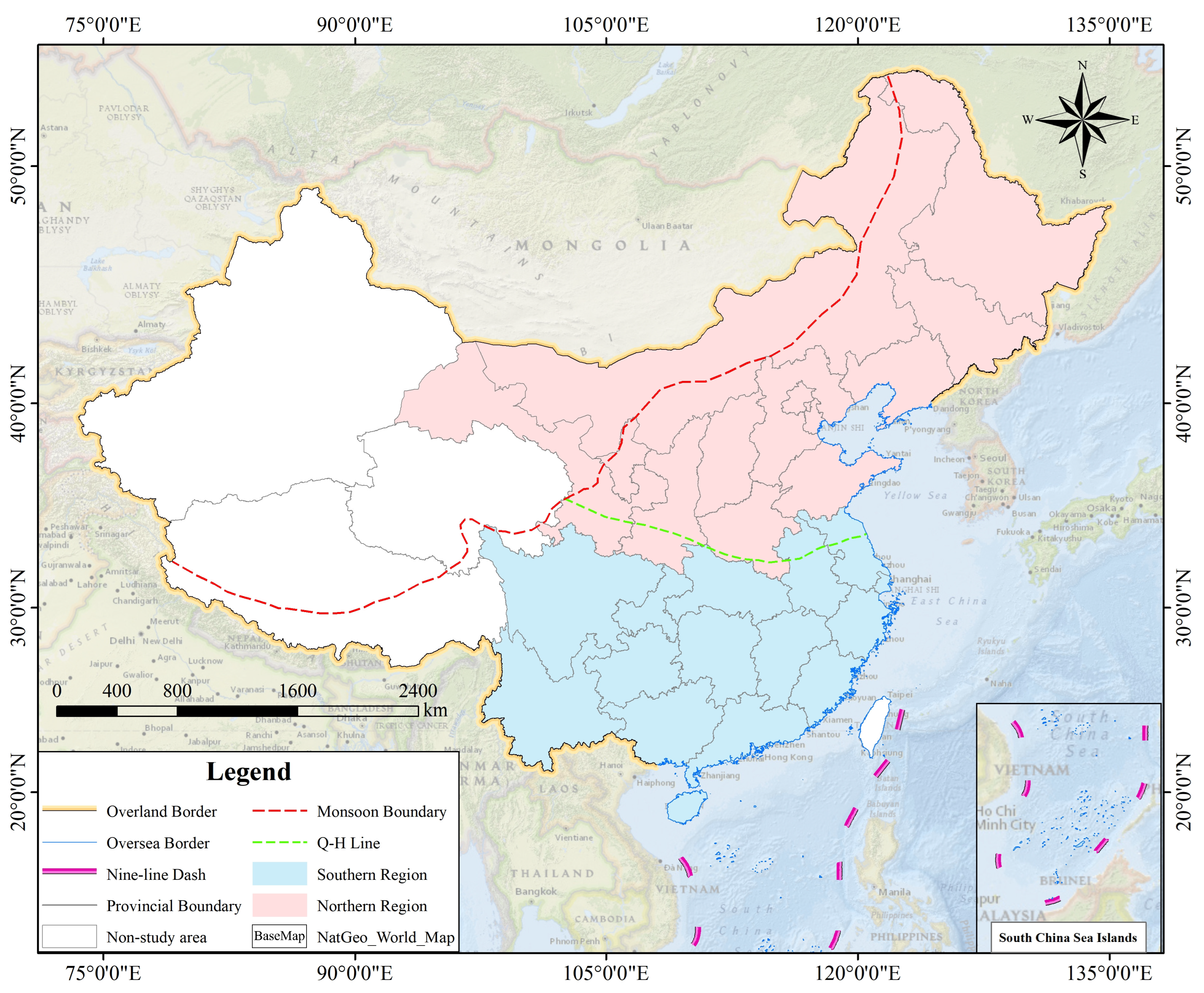
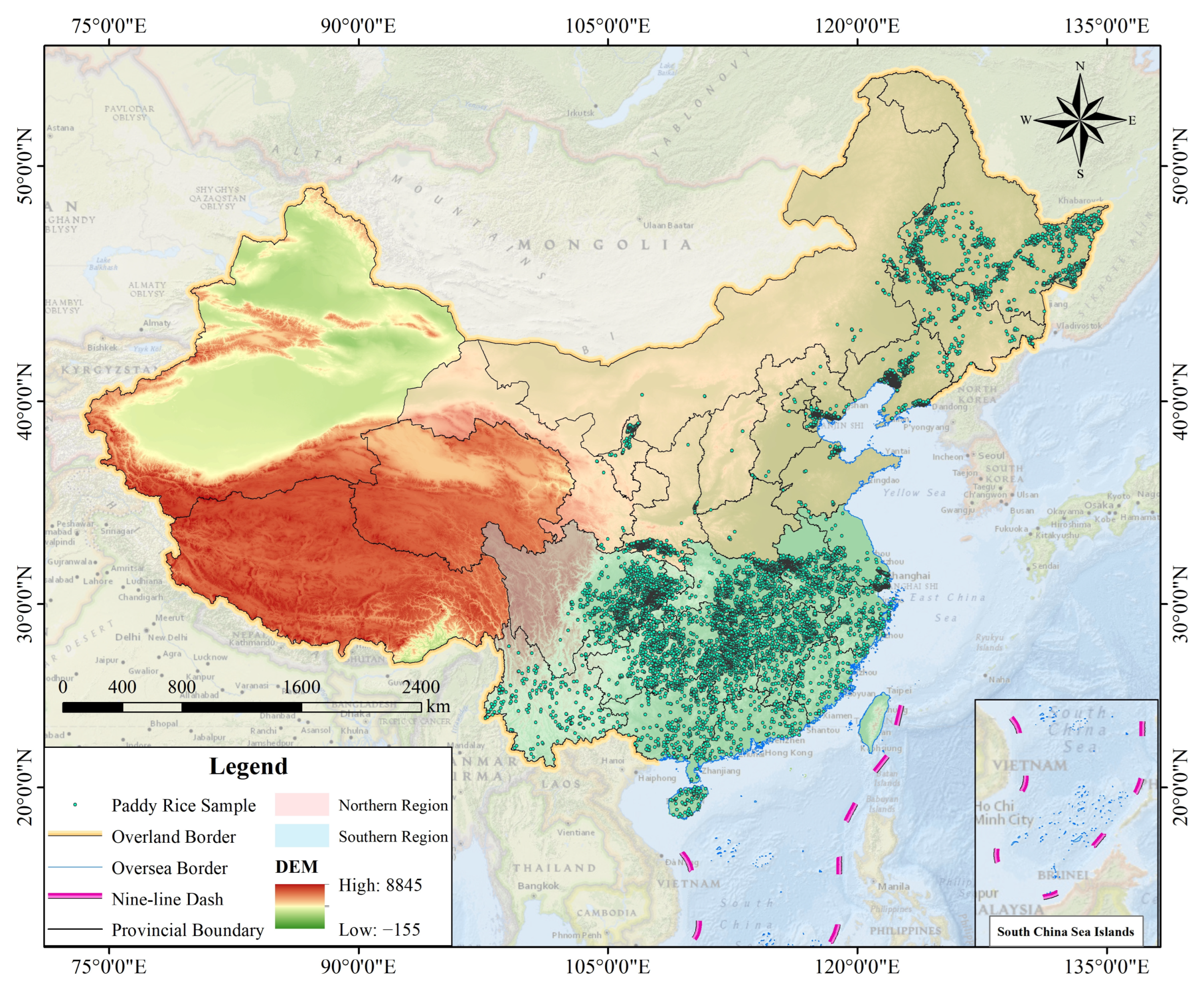


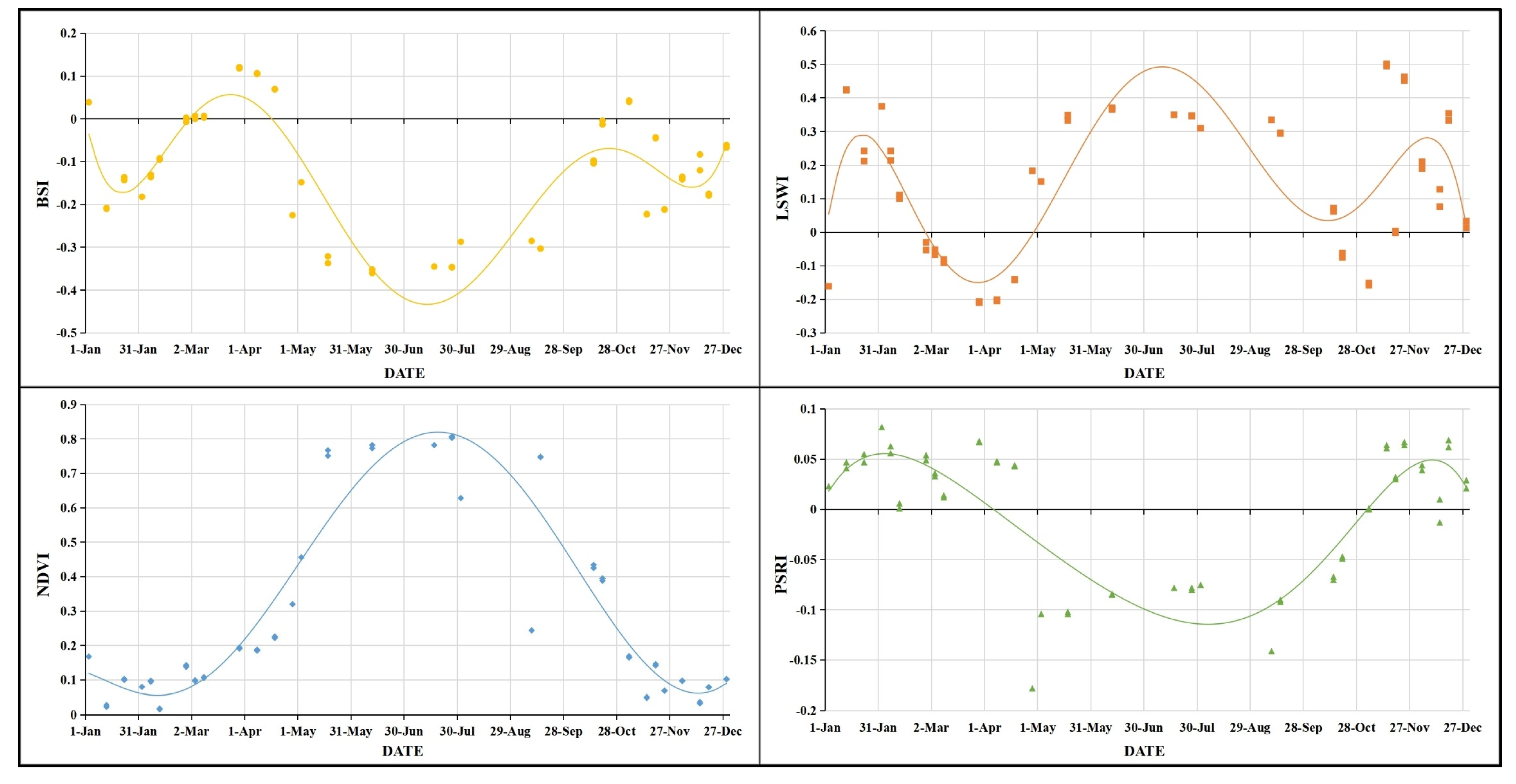
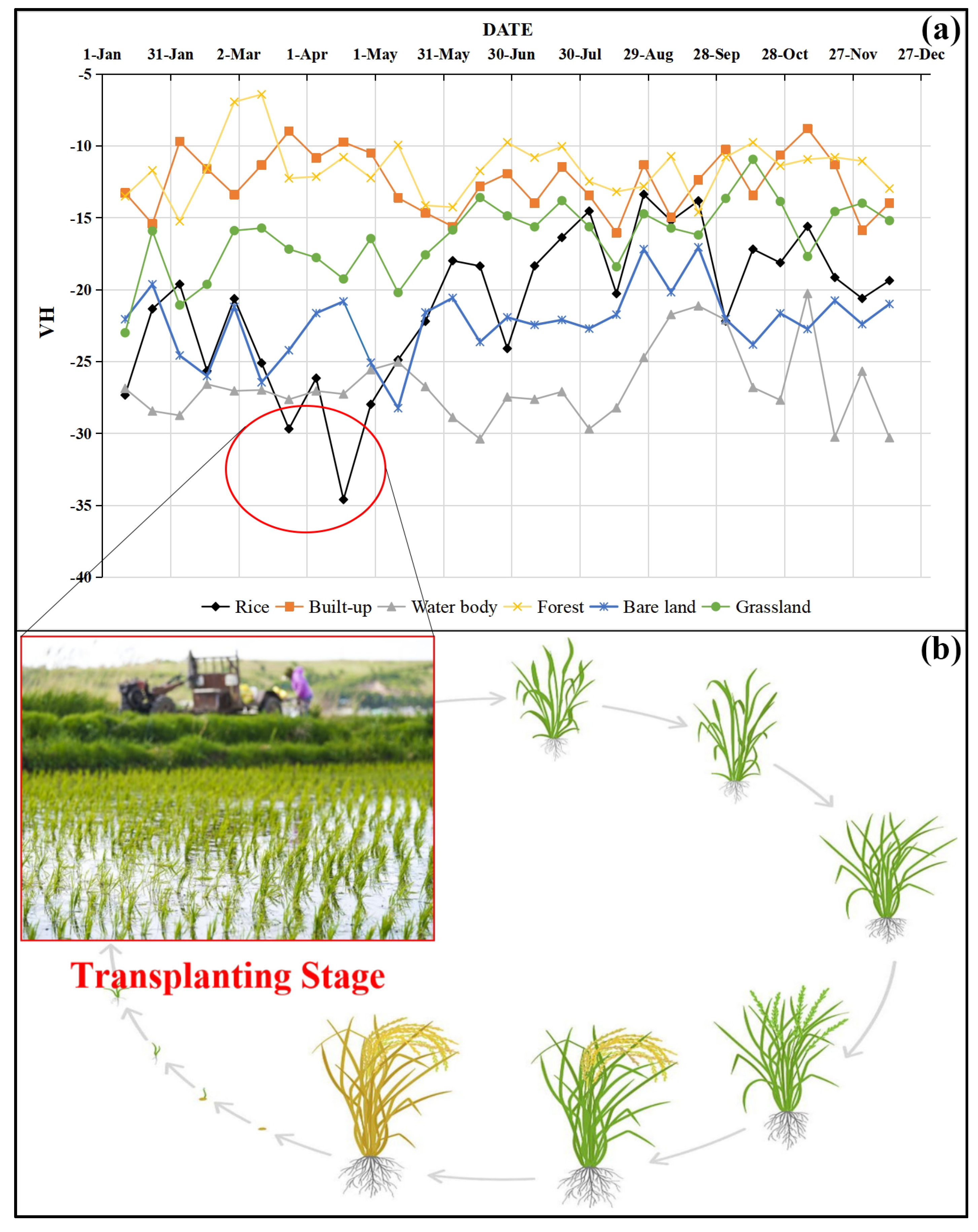
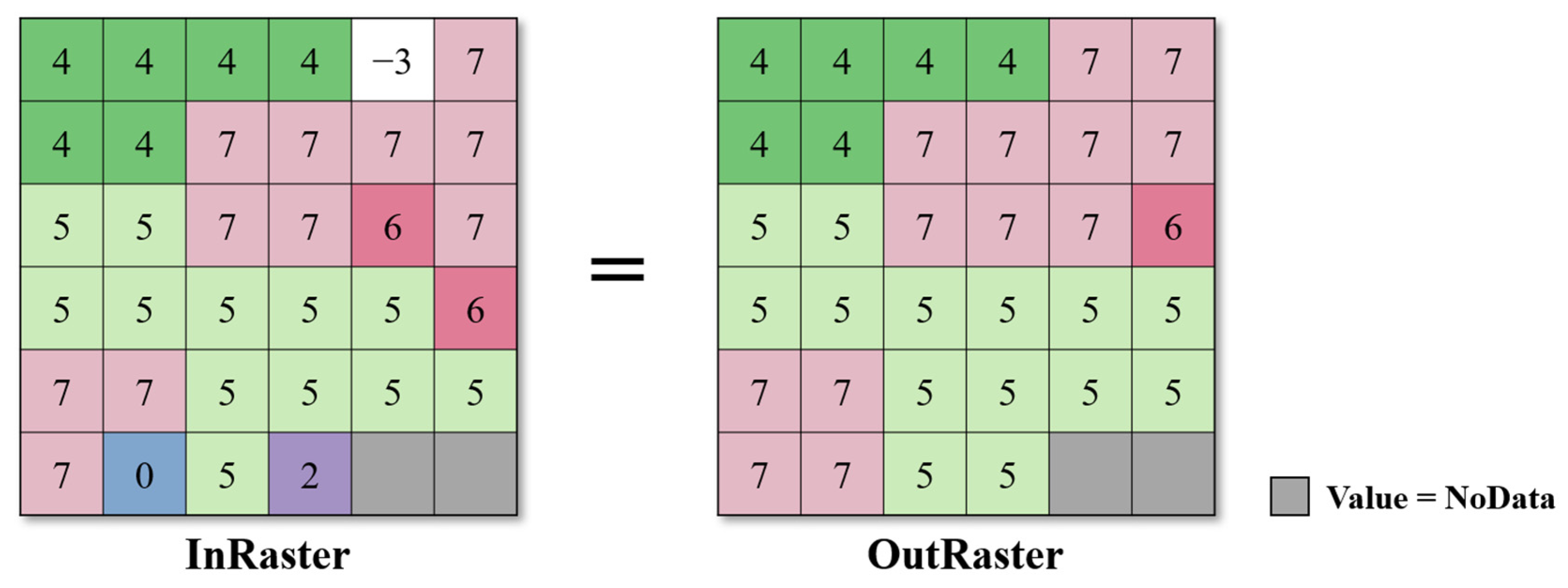
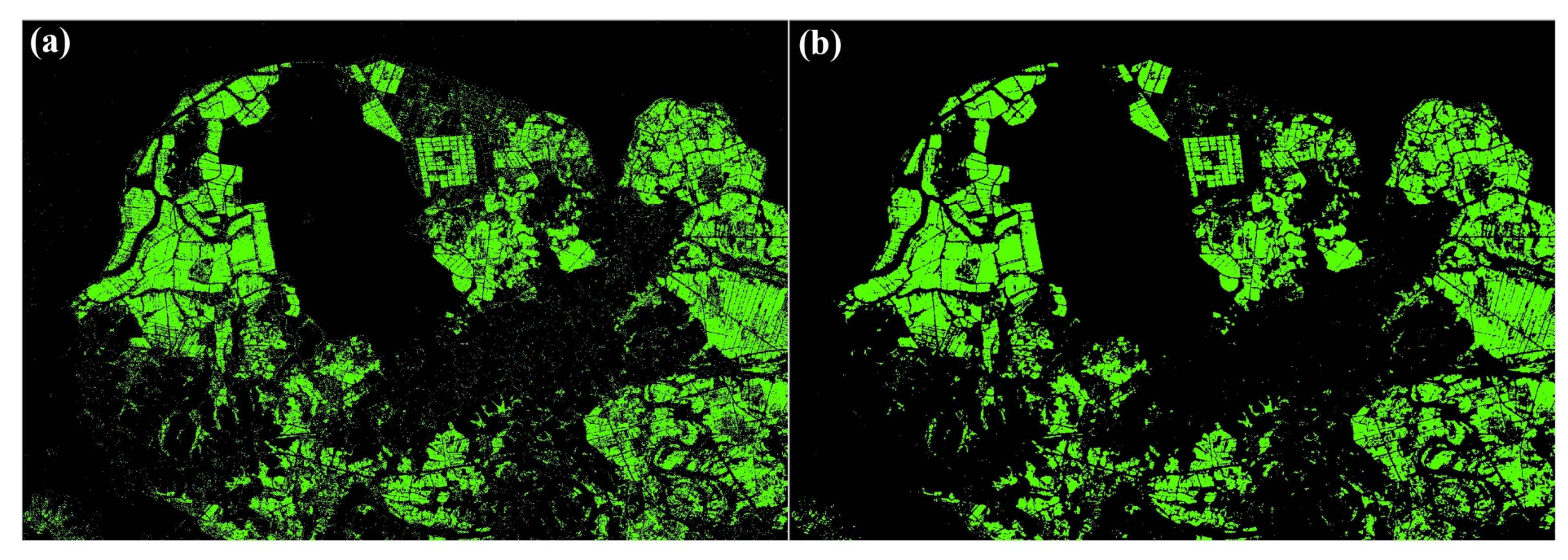
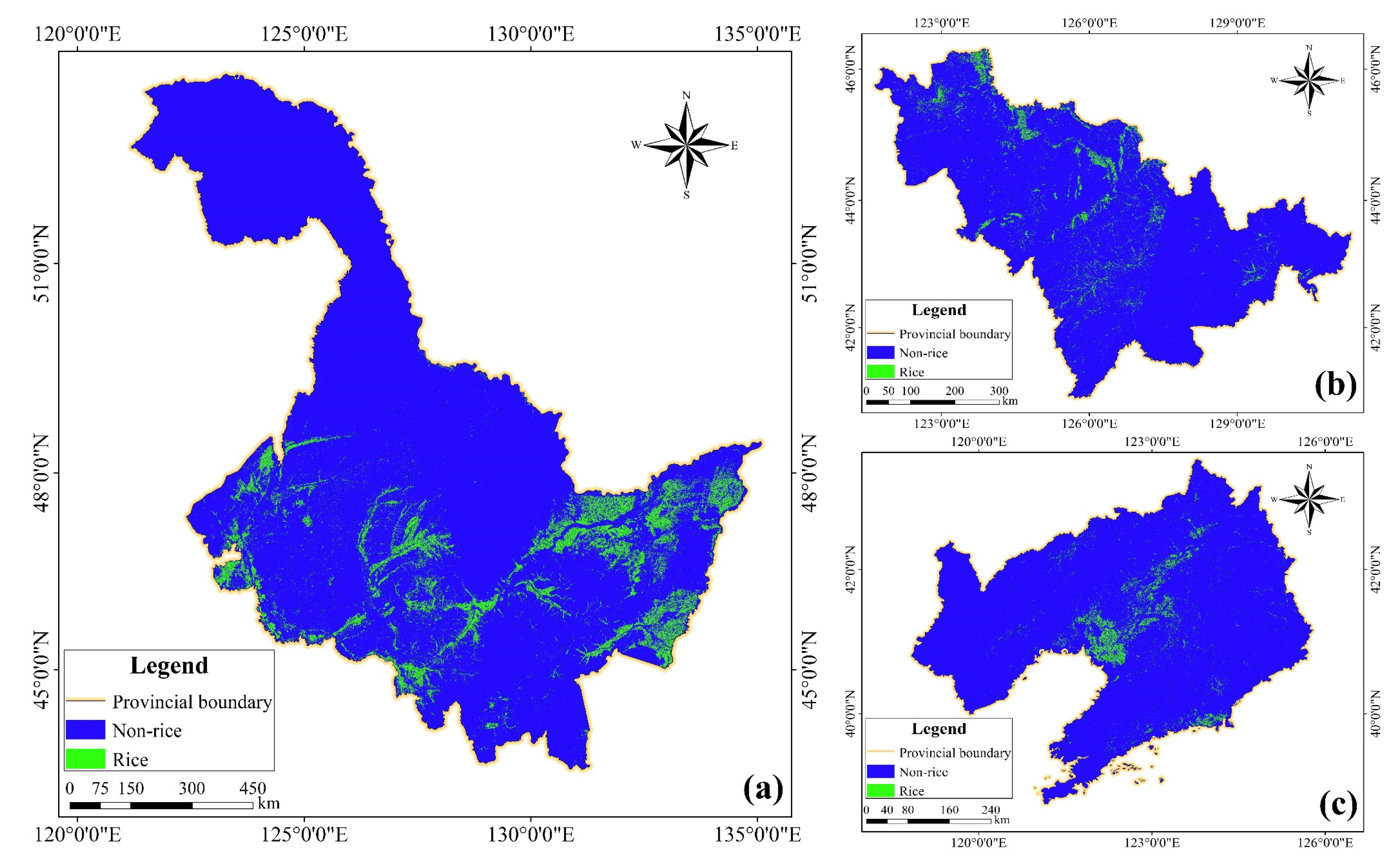
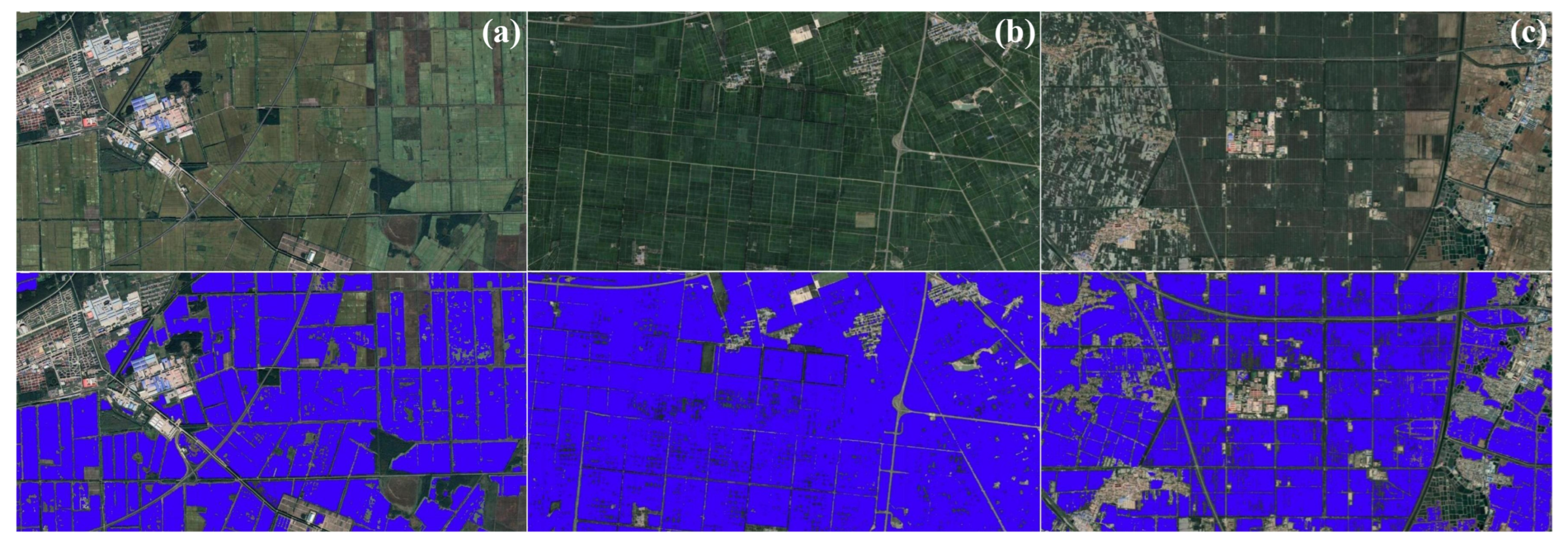
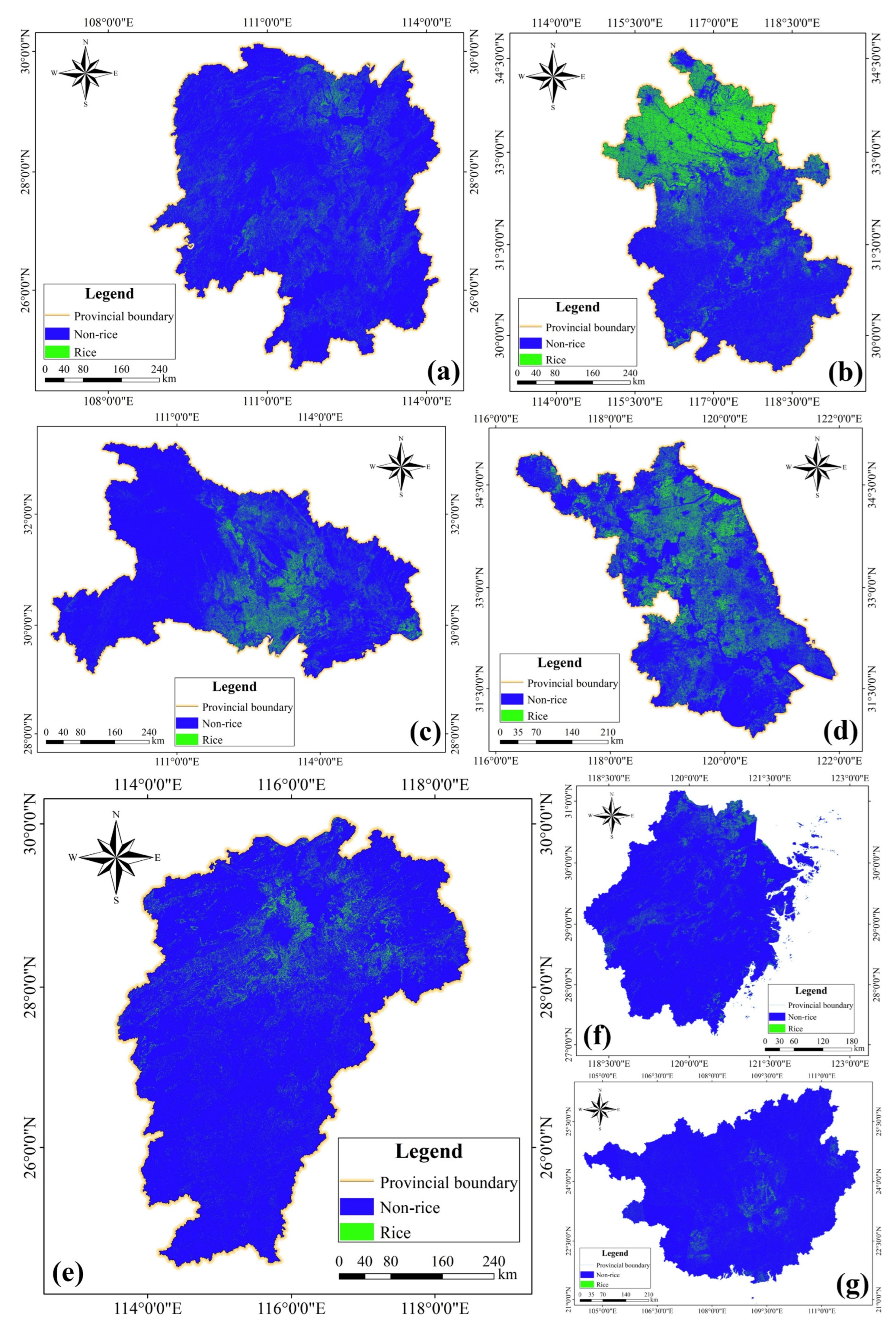
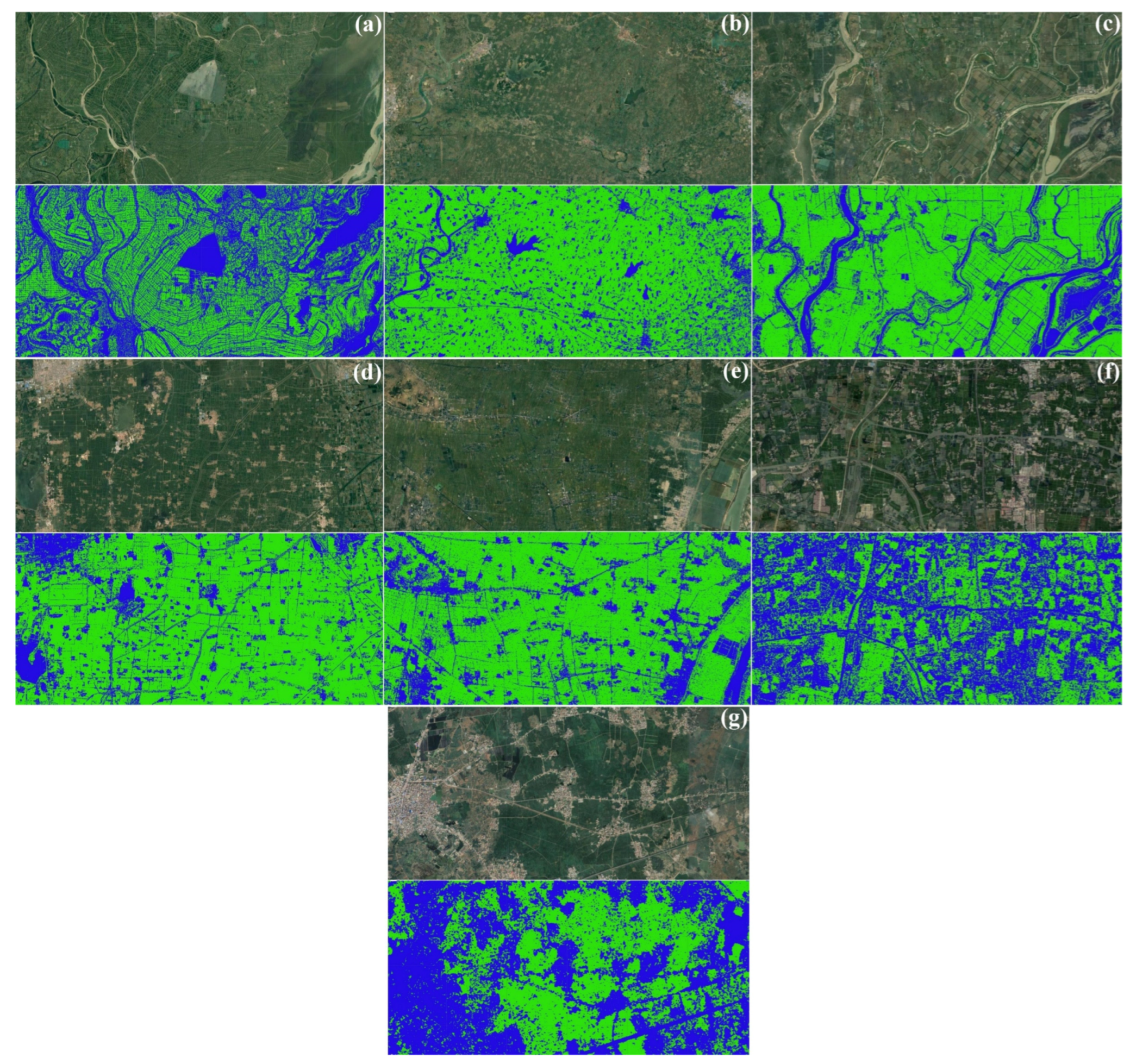
| Area/Characteristic | Monsoon Area | Non-Monsoon Area |
|---|---|---|
| Precipitation | Over 400 mm per year | Below 400 mm per year |
| Relationship between Humidity and Temperature | Synchronous | Out of sync |
| Terrain Type | Plains, basins, and hills | Plateau, mountain, and basin |
| Vegetation Type | Forests and grasslands | Grasslands and deserts |
| River Type | Exoreic rivers mainly recharged by rainwater | Internal streams recharged by melting of snow and ice |
| Agricultural Production Mode | Farming-dominated | Livestock-dominated |
| Satellite/Property | Sentinel-1 | Sentinel-2 |
|---|---|---|
| Product Name | Sentinel-1 SAR GRD | Harmonized Sentinel-2 MSI, Level-1C |
| Time Coverage | 1 January–31 December 2021 | 1 January–31 December 2021 |
| Data Unit | dB | Numerical value |
| Spatial Resolution | 10 m | 10–20 m |
| Temporal Resolution | 12 d | 5 d |
| Polarization/Band | VH (IW Mode) | B2 (Blue) B4 (Red) B8 (NIR) B3 (Green) B11, B12 (SWIR) B5-B7, B8A (Red Edge) |
| Pre-processing Steps | Thermal noise removal, Radiometric calibration, Terrain correction | Preliminary cloud removal |
| Optical Index | Calculation Formula 1 | Phenological Stages |
|---|---|---|
| Bare Soil Index (BSI) | Bare Soil Stage | |
| Land Surface Water Index (LSWI) | Transplanting Stage | |
| Normalized Difference Vegetation Index (NDVI) | Growing Stage | |
| Plant Senescence Reflectance Index (PSRI) | Mature Stage | |
| Enhanced Vegetation Index (EVI) | Growing Stage | |
| Green Chlorophyll Vegetation Index (GCVI) | Transplanting Stage |
| Region/Stage | Jianghuai 2 | Jiangnan 3 | Huanan 4 | Xinan 5 |
|---|---|---|---|---|
| Sowing Stage | - 6 | 4.1–4.30 | 1.21–2.20 | 3.11–3.20 |
| Seedling Stage | 4.11–5.31 | 5.1–5.31 | 2.21–3.20 | 3.21–3.31 |
| Transplanting Stage | 6.1–6.10 | 6.1–6.10 | 4.1–4.20 | 4.1–5.20 |
| Greening Stage | 6.11–6.20 | 6.11–6.20 | - | - |
| Tillering Stage | 6.21–7.31 | 6.21–7.31 | 4.21–5.31 | 5.21–7.10 |
| Booting Stage | 8.1–8.10 | - | 6.1–6.10 | 7.11–7.31 |
| Heading Stage | 8.11–8.20 | 8.1–8.10 | 6.11–6.20 | 8.1–8.10 |
| Grouting Stage | 8.21–8.31 | 8.11–8.20 | - | 8.11–8.20 |
| Milk-ripe Stage | 9.1–9.10 | 8.21–10.31 | 6.21–6.30 | 8.21–9.20 |
| Mature Stage | 9.11–9.20 | - | 7.11–7.31 | 9.21–10.20 |
| Province/ Index | Heilongjiang | Jilin | Liaoning |
|---|---|---|---|
| Buffer Size N (m) | 10 | 10 | 10 |
| Confusion Matrix | [62, 2], [0, 43] | [55, 7], [0, 38] | [43, 5], [0, 29] |
| User’s Accuracy (UA) | 0.9556 | 0.8444 | 0.8529 |
| Producer’s Accuracy (PA) | 0.9688 | 0.8871 | 0.8958 |
| Overall Accuracy (OA) | 0.98 | 0.93 | 0.94 |
| Kappa Coefficient (KC) | 0.96 | 0.87 | 0.87 |
| Mapping Result Area (km2) | 37,345.73 | 8139.26 | 5009.72 |
| Reference Area (km2) | 38,670 | 8373 | 5206 |
| Relative Error (%) | −3.42 | −2.79 | −3.77 |
| Province | Hunan | Hubei | Jiangxi | Jiangsu | Anhui | Zhejiang | Guangxi |
|---|---|---|---|---|---|---|---|
| Buffer Size N (m) | 3 | 5 | 4 | 5 | 5 | 3 | 2 |
| Confusion Matrix | [68, 22], [4, 67] | [94, 12], [12, 72] | [62, 16], [9, 51] | [93, 7], [5, 77] | [100, 6], [5, 38] | [80, 7], [10, 44] | [104, 3], [6, 22] |
| User’s Accuracy (UA) | [0.94, 0.75] | [0.89, 0.86] | [0.87, 0.76] | [0.95, 0.92] | [0.95, 0.86] | [0.89, 0.86] | [0.95, 0.88] |
| Producer’s Accuracy (PA) | [0.76, 0.94] | [0.89, 0.86] | [0.79, 0.85] | [0.93, 0.94] | [0.94, 0.88] | [0.89, 0.86] | [0.97, 0.79] |
| Overall Accuracy (OA) | 0.88 | 0.84 | 0.87 | 0.93 | 0.93 | 0.88 | 0.93 |
| Kappa Coefficient (KC) | 0.78 | 0.74 | 0.83 | 0.87 | 0.82 | 0.74 | 0.79 |
| F-score | [0.88, 0.75] | [0.90, 0.90] | [0.90, 0.89] | [0.94, 0.93] | [0.95, 0.87] | [0.90, 0.84] | [0.96, 0.83] |
| Mapping Result Area (km2) | 13,298.61 | 21,230.76 | 8963.92 | 23,793.60 | 26,755.34 | 5035.26 | 7285.36 |
| Reference Area (km2) | 14761 | 20192 | 9400 | 22192 | 25121 | 5314 | 8075 |
| Relative Error (%) | −9.91 | 5.14 | −4.64 | 7.22 | 6.51 | −5.25 | −9.78 |
Disclaimer/Publisher’s Note: The statements, opinions and data contained in all publications are solely those of the individual author(s) and contributor(s) and not of MDPI and/or the editor(s). MDPI and/or the editor(s) disclaim responsibility for any injury to people or property resulting from any ideas, methods, instructions or products referred to in the content. |
© 2023 by the authors. Licensee MDPI, Basel, Switzerland. This article is an open access article distributed under the terms and conditions of the Creative Commons Attribution (CC BY) license (https://creativecommons.org/licenses/by/4.0/).
Share and Cite
Huang, C.; You, S.; Liu, A.; Li, P.; Zhang, J.; Deng, J. High-Resolution National-Scale Mapping of Paddy Rice Based on Sentinel-1/2 Data. Remote Sens. 2023, 15, 4055. https://doi.org/10.3390/rs15164055
Huang C, You S, Liu A, Li P, Zhang J, Deng J. High-Resolution National-Scale Mapping of Paddy Rice Based on Sentinel-1/2 Data. Remote Sensing. 2023; 15(16):4055. https://doi.org/10.3390/rs15164055
Chicago/Turabian StyleHuang, Chenhao, Shucheng You, Aixia Liu, Penghan Li, Jianhua Zhang, and Jinsong Deng. 2023. "High-Resolution National-Scale Mapping of Paddy Rice Based on Sentinel-1/2 Data" Remote Sensing 15, no. 16: 4055. https://doi.org/10.3390/rs15164055
APA StyleHuang, C., You, S., Liu, A., Li, P., Zhang, J., & Deng, J. (2023). High-Resolution National-Scale Mapping of Paddy Rice Based on Sentinel-1/2 Data. Remote Sensing, 15(16), 4055. https://doi.org/10.3390/rs15164055






